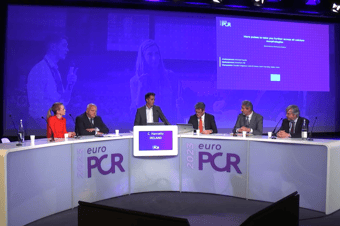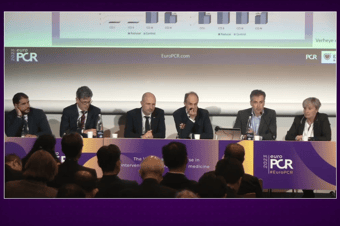EuroPCR 2023: What a Blast!
EuroPCR 2023 was a real blast for Shockwave Medical! Three sponsored sessions, two featured live cases, one interview on PCR TV and many, many invaluable conversations at our booth. Thank you to all of you who attended for making this our best EuroPCR so far!
In case you didn’t make it or would like to watch the Shockwave Medical sessions again, here are the main highlights and recordings:
MORE PULSES TO TAKE YOU FURTHER ACROSS ALL CALCIUM MORPHOLOGIES

Rewatch our Case in Point if you want to hear:
- Dr. C. Cosgrove explaining IVL MOA and highlighting Shockwave C2+ key features.
- Prof. C. Di Mario, Dr. C. Hanratty and Dr. S. Harb sharing great case examples of IVL across a range of calcium morphologies.
IVL IN THE REAL WORLD: THE REVOLUTION CONTINUES

- Prof. J. Escaned shared his 5-year journey with IVL and lessons learned along the way.
- Dr. Z. Ali presented the recent data from atherosclerotic cadaver study on the evaluation of IVL fractures by histology, OCT and Micro-CT.
- Dr. A. Cid Alvarez presented REPLICA-EPIC18 data, the first perspective real-world data set with 1-year clinical follow-up, confirming that IVL is consistently safe and effective in a real-world complex patient population.
- Dr. A. Seth presented a couple of cases with heavily calcified lesions from the Indian Registry that will be showed at TCT later this year.
CORONARY SINUS REDUCER*: INSIGHTS INTO TREATING REFRACTORY ANGINA PATIENTS WITH OBSTRUCTIVE AND NON-OBSTRUCTIVE CAD

In this session, the faculty did an excellent job explaining:
- How the Reducer helps patients with refractory angina
- Reviewing the most relevant clinical data
- Showing how to implant the device in the coronary sinus
*This content is intended for European audiences only. Reducer is a US investigational device limited by US law to investigational use only.
EUROPCR INTERVIEWS

Watch this PCR Round Table Discussion with Prof J. Spratt and Dr. A. McInerney to learn about new developments in IVL after 5 years of clinical practice.
SHOCKWAVE C2+ LIVE IN ACTION
Don’t miss the EuroPCR live cases featuring Shockwave IVL. Rewatch the sessions following the links below to the PCR Online webpage*.
CALCIFIED LESIONS: LIVE Case from Institut Cardiovasculaire Paris Sud, Massy - France
BIFURCATION: LIVE Case from Policlinico Universitario Fondazione Agostino Gemelli, Rome - Italy
*These links require access to the EuroPCR 2023 content via subscription
To keep up on the real-time Shockwave IVL activities, follow @ShockwaveIVL on Twitter!
Coronary IVL Important Safety Information
Please contact your local Shockwave representative for specific country availability and refer to the Shockwave C2 and Shockwave C2+ instructions for use containing important safety information.
In the United States: Rx only
Indications for Use—The Shockwave Intravascular Lithotripsy (IVL) System with the Shockwave C2 Coronary IVL Catheter is indicated for lithotripsy enabled, low-pressure balloon dilatation of severely calcified, stenotic de novo coronary arteries prior to stenting.
Contraindications—The Shockwave C2 Coronary IVL System is contraindicated for the following: This device is not intended for stent delivery. This device is not intended for use in carotid or cerebrovascular arteries.
Warnings— Use the IVL Generator in accordance with recommended settings as stated in the Operator’s Manual. The risk of a dissection or
perforation is increased in severely calcified lesions undergoing percutaneous treatment, including IVL. Appropriate provisional interventions should be readily available. Balloon loss of pressure was associated with a numerical increase in dissection which was not statistically significant and was not associated with MACE. Analysis indicates calcium length is a predictor of dissection and balloon loss of pressure. IVL generates mechanical pulses which may cause atrial or ventricular capture in bradycardic patients. In patients with implantable pacemakers and defibrillators, the asynchronous capture may interact with the sensing capabilities. Monitoring of the electrocardiographic rhythm and continuous arterial pressure during IVL treatment is required. In the event of clinically significant hemodynamic effects, temporarily cease delivery of IVL therapy.
Precautions— Only to be used by physicians trained in angiography and intravascular coronary procedures. Use only the recommended balloon
inflation medium. Hydrophilic coating to be wet only with normal saline or water and care must be taken with sharp objects to avoid damage to the hydrophilic coating. Appropriate anticoagulant therapy should be administered by the physician. Precaution should be taken when treating patients with previous stenting within 5mm of target lesion.
Potential adverse effects consistent with standard based cardiac interventions include– Abrupt vessel closure – Allergic reaction to contrast medium, anticoagulant and/or antithrombotic therapy-Aneurysm-Arrhythmia-Arteriovenous fistula-Bleeding complications-Cardiac tamponade or pericardial effusion-Cardiopulmonary arrest-Cerebrovascular accident (CVA)-Coronary artery/vessel occlusion, perforation, rupture or dissection-Coronary artery spasm-Death-Emboli (air, tissue, thrombus or atherosclerotic emboli)-Emergency or non-emergency coronary artery bypass surgery-Emergency or non-emergency percutaneous coronary intervention-Entry site complications-Fracture of the guide wire or failure/malfunction of any component of the device that may or may not lead to device embolism, dissection, serious injury or surgical intervention-Hematoma at the vascular access site(s)-Hemorrhage-Hypertension/Hypotension-Infection/sepsis/fever-Myocardial Infarction-Myocardial Ischemia or unstable angina-Pain-Peripheral Ischemia-Pseudoaneurysm-Renal failure/insufficiency-Restenosis of the treated coronary artery leading to revascularization-Shock/pulmonary edema-Slow flow, no reflow, or abrupt closure of coronary artery-Stroke-Thrombus-Vessel closure, abrupt-Vessel injury requiring surgical repair-Vessel dissection, perforation, rupture, or spasm.
Risks identified as related to the device and its use: Allergic/immunologic reaction to the catheter material(s) or coating-Device malfunction, failure, or balloon loss of pressure leading to device embolism, dissection, serious injury or surgical intervention-Atrial or ventricular extrasystole-Atrial or ventricular capture.
Prior to use, please reference the Instructions for Use for more information on warnings, precautions and adverse events.
https://shockwavemedical.com/IFU
Neovasc Reducer Important Safety Information
Intended for physicians in countries with Reducer commercially available. Please contact your local representative for specific country availability.
Prior to use, please reference the Instructions for Use for more information on warnings, precautions and adverse events: ifu.neovasc.com.
Caution: In the United States, Reducer is an investigational device, limited by United States law to investigational use.







